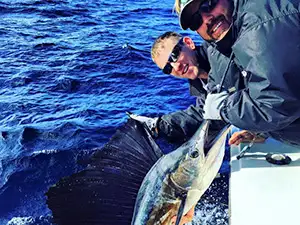Key Biscayne Fishing Charters
Key Biscayne fishing charters give anglers fast access to Biscayne Bay’s flats, mangrove shorelines, and offshore reefs, with tarpon, snapper, and sailfish all within striking distance.
Top Rated Charters in Key Biscayne
TrustedFish connects anglers with proven local captains in Key Biscayne, Florida —no commissions, no pay-to-play listings, no BS. Every charter on our platform is invite-only, vetted for skill, local knowledge, and reputation. If they’re listed, they’ve earned it.
Key Biscayne Fishing Guide
Key Biscayne sits at the southern edge of Miami, but the fishing here feels far removed from the city. Most charters launch from Crandon Marina or Bill Baggs State Park and run half-day or full-day trips, depending on the season and target species. Inshore fishing revolves around the grass flats and channels of Biscayne Bay, where bonefish, permit, and tarpon cruise in skinny water. The nearby cuts and bridges also hold snook and jacks, especially around moving tides.
For nearshore and reef trips, captains often work the patch reefs and wrecks just offshore, typically in 30 to 100 feet of water. Yellowtail snapper, mutton snapper, grouper, and cero mackerel are common catches here, especially when fishing with live pilchards or cut bait on a knocker rig or jighead. Light tackle and chumming are go-to methods.
When the weather allows, many deep sea charters push offshore to the edge of the Gulf Stream, usually a 6–15 mile run. This puts sailfish, mahi-mahi, blackfin tuna, and kingfish in play, especially from fall through spring. Kite fishing with live goggle-eyes is a staple for sailfish, while trolling lures or rigged ballyhoo works well for pelagics. Drift fishing and vertical jigging also produce on the deeper wrecks.
With its mix of inshore and offshore access, Key Biscayne is one of the most versatile fisheries in South Florida—quiet enough to sight-cast bonefish in a foot of water, yet close enough to run for sails before lunch.
Fishing Seasons in Key Biscayne
Spring
Tarpon fishing kicks into high gear in Biscayne Bay, especially near channels and bridges. Bonefish and permit tail on the flats during calmer mornings. Offshore, sailfish are still active along with increasing numbers of mahi and blackfin tuna.
Summer
The flats come alive with bonefish and permit. Early morning tarpon bites are still possible, especially near ocean-side cuts. Offshore, expect calm seas and great action for mahi-mahi, with snapper and grouper on the reefs.
Fall
Sailfish return as cold fronts approach, and the offshore bite fires back up. Inshore, look for snook around structure and good shots at bonefish on cooler, clear days. Mutton snapper and yellowtails are steady reef targets.
Winter
Peak season for sailfish, especially with kite setups. The reef bite for snapper, grouper, and mackerel is dependable. Inshore, cooler water concentrates bonefish on deeper flats and brings consistent action around the cuts for jacks and snook.
Gamefish in Key Biscayne
- Tarpon – 40–150 lbs Caught around bridges and channels on live mullet, crabs, or artificial swimbaits. Best in spring and summer during dawn or dusk tides.
- Bonefish – 4–10 lbs Found tailing on shallow flats. Sight-cast shrimp or small jigs on light spinning or fly gear.
- Sailfish – 30–70 lbs Targeted offshore in winter and spring using live bait on kites near the edge of the Gulf Stream.
- Mahi-Mahi – 5–30 lbs Trolled or sight-cast offshore near weedlines and color changes. Peak season is summer.
- Mutton Snapper – 5–15 lbs Caught on bottom rigs with cut bait around wrecks and patch reefs, especially during summer and fall.
- Grouper – 10–30 lbs Fish deep structure with live pinfish or dead bait on heavy tackle. Best during cooler months.
- Snook – 5–20 lbs Ambush predators around bridges and mangroves. Fish live pilchards, mullet, or topwater plugs.
- Blackfin Tuna – 10–30 lbs Found along offshore rips. Trolled feathers, vertical jigs, or live bait near the surface.
- Yellowtail Snapper – 1–4 lbs Common on patch reefs. Chum heavily and use small hooks with squid or cut baits.
Key Biscayne Fishing FAQs
What types of fishing charters run out of this area?
Most local charters offer half-day inshore or reef trips and full-day offshore runs. Inshore trips explore Biscayne Bay, while offshore trips target species near the Gulf Stream.
Do I need a fishing license?
No. If you’re fishing with a licensed guide, the captain’s license covers everyone on board for both inshore and offshore waters.
What’s the best time of year for sailfish?
Depending on the trip, captains may fish a few miles out in the bay or travel 30–50 miles to rich offshore grounds..
Where do most charters launch from?
Bring your fishing license, warm layered clothing, lunch, and motion sickness meds if needed. Most gear is included.
What should I bring on a trip?
Bring sun protection, snacks, water, and polarized sunglasses. Captains typically supply rods, tackle, bait, and a cooler with ice.
Is tarpon fishing good around here?
Yes. Tarpon are a major inshore target from March through July, especially near channels and bridges.
Are reef trips productive year-round?
They are. Yellowtail snapper, grouper, and mackerel hold steady through all seasons, though summer and winter tend to be strongest.
How far offshore do deep sea charters go?
Most trips run 6–15 miles to reach the Gulf Stream edge, usually less than an hour depending on conditions.
Can I book a fly fishing trip?
Definitely. Fly anglers often target bonefish, permit, and juvenile tarpon on the flats. Many local guides can provide gear or accommodate your own.


